Chouteau’s Church (St. Francis Regis) Historical Marker
Introduction
Text-to-speech Audio
Constructed out of logs in 1835, the original church at this location was built by French speaking villagers living in the small farming village of Chez les Canses, the first permanent colony which became Kansas City. Originally called St. Francis Regis, this wooden structure was demolished in 1857 to make way for a new brick building to house a new church. Construction was overseen by Irish priest and civil engineer Father Bernard Donnelly, who hired hundreds of Irish laborers for the project. The church was deemed a cathedral in 1880 and additions were completed in 1883, including the iconic gold dome. This brick church continues to operate today as the Cathedral of the Immaculate Conception.
Images
English side of the marker, courtesy of Thomas Onions
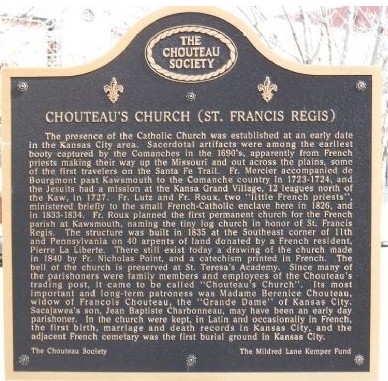
French side of the marker, courtesy of Thomas Onions
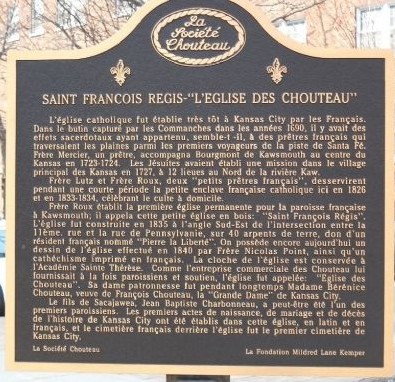
The original 1833 log church of St. Francis Regis. Courtesy of Missouri Valley Special Collections, Kansas City Public Library, Kansas City, Missouri.
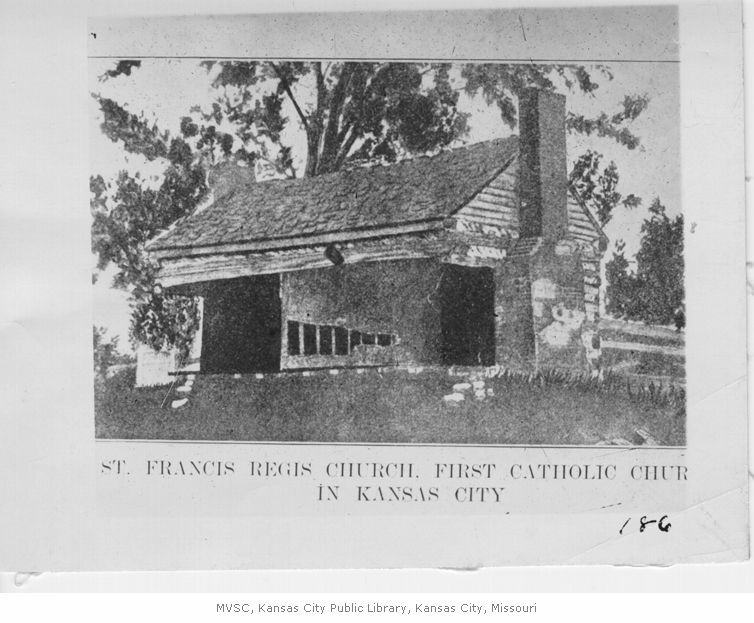
Drawing of the original church in 1840 by Nicholas Point
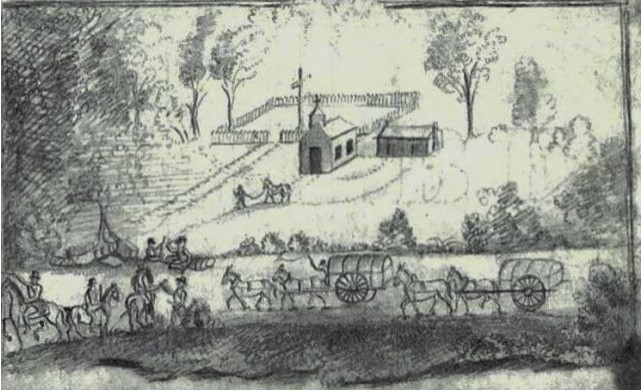
St. Francis Regis church built in 1857, prior to the Cathedral additions in 1883. Courtesy of Missouri Valley Special Collections, Kansas City Public Library, Kansas City, Missouri.
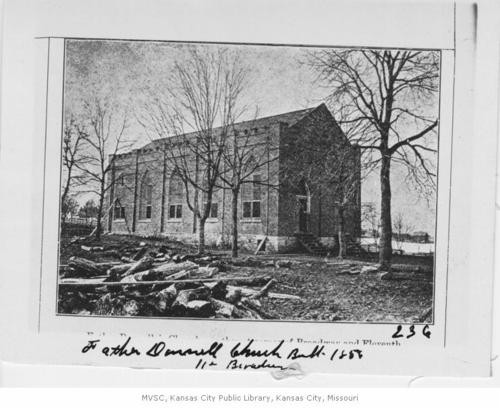
The Cathedral of Immaculate Conception today
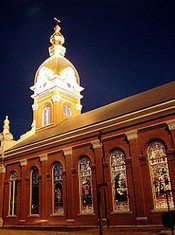
Backstory and Context
Text-to-speech Audio
In 1833, French priest Father Benedict Roux arrived at the small Francophone community of Chez les Canses at the confluence of the Missouri and Kansas rivers. He was under orders from the Catholic church to establish and minister a church for the fledgling community. The original church was built out of logs in 1835 and named after St. John Francis Regis. The nearby village provided the labor for construction. Chez les Canses was destroyed by a flood in 1844, but the church survived. Around the time of the village's destruction was just when people started to move to Kansas City en masse.
In 1850, Kansas City was first incorporated as a town and three years later it was officially a city growing rapidly around the church. An Irish priest named Father Bernard Donnelly replaced Roux in 1845, and by the mid 1850’s it was clear that Kansas City needed a more permanent church. Donnelly had experience as a civil engineer so in 1857 he hired hundreds of immigrant laborers to construct a new church made of brick on the same location as the first church. This was largely paid for by donations from prominent Kansas Citians of that era. At this point, the church lost its last connections to French heritage with its name changed to the Church of the Immaculate Conception.
Kansas City eventually grew so much in population that in 1880, the Diocese of Kansas City was formed and the Catholic Church in Rome deemed the church a cathedral. With an increasing congregation, they decided to expand upon the original 1857 brick building, which was completed in 1883. Amongst the additions was the Cathedral’s iconic gold dome. The original brick building still serves as the central structure for the Cathedral.
The text of this historical marker reads as follows:
The presence of the Catholic Church was established at an early date in the Kansas City area. Sacerdotal artifacts were among the earliest booty captured by the Comanches in the 1690's, apparently from French priests making their way up the Missouri and out across the plains, some of the first travelers on the Santa Fe Trail. Fr. Mercier accompanied de Bourgemont past Kawsmouth to the Comanche country in 1723-1724, and the Jesuits had a mission at the Kansa Grand Village, 12 leagues north of the Kaw, in 1727. Fr. Lutz and Fr. Roux, two "little French priests"; ministered briefly to the small French-Catholic enclave here in 1826, and in 1833-1834. Fr. Roux planned the first permanent church for the French parish at Kawsmouth, naming the tiny log church in honor of St. Francis Regis. The structure was built in 1835 at the Southeast corner of 11th and Pennsylvania on 40 arpents of land donated by a French resident, Pierre La Liberte. There still exists today a drawing of the church made in 1840 by Fr. Nicholas Point, and a catechism printed in French. The bell of the church is preserved at St Teresa's Academy. Since many of the parishioners were family members and employees of the Chouteau's trading post, it came to be called "Chouteau's Church". Its most important and long term patroness was Madame Berenice Chouteau, widow of Francois Chouteau, the "Grande Dame" of Kansas City. Sacajawea's son, Jean Baptiste Charbonneau, may have been an early day parishioner. In the church were kept, in Latin and occasionally in French, the first birth, marriage and death records in Kansas City, and the adjacent French cemetery was the first burial ground in Kansas City.
Sources
Chouteau’s Church (St. Francis Regis) Saint Francois Regis-“L’Eglise Des Chouteau”, The Historical Markers Database. Accessed July 28th, 2022. https://www.hmdb.org/m.asp?m=86217.
CATHEDRAL HISTORY, KC Gold Dome. Accessed August 11th, 2022. https://kcgolddome.org/about-us/.
Fr. Bernard Donnelly: "The Builder" of Kansas City, The New Santa Fe Trailer. Accessed August 11th, 2022. https://newsantafetrailer.blogspot.com/2019/04/fr-bernard-donnelly-builder-of-kansas.html?fbclid=IwAR08sFzJ94ywGfcoz7nP1jkv4Ow9EOI_2vKEpD5V8fxu7eCvwtgd5pu5W3g.
https://www.hmdb.org/m.asp?m=86217
https://www.hmdb.org/m.asp?m=86217
https://kchistory.org/image/st-francis-regis-rectory
https://newsantafetrailer.blogspot.com/2019/04/fr-bernard-donnelly-builder-of-kansas.html?fbclid=IwAR08sFzJ94ywGfcoz7nP1jkv4Ow9EOI_2vKEpD5V8fxu7eCvwtgd5pu5W3g
https://kchistory.org/image/immaculate-conception-church
https://newsantafetrailer.blogspot.com/2019/04/fr-bernard-donnelly-builder-of-kansas.html?fbclid=IwAR08sFzJ94ywGfcoz7nP1jkv4Ow9EOI_2vKEpD5V8fxu7eCvwtgd5pu5W3g
